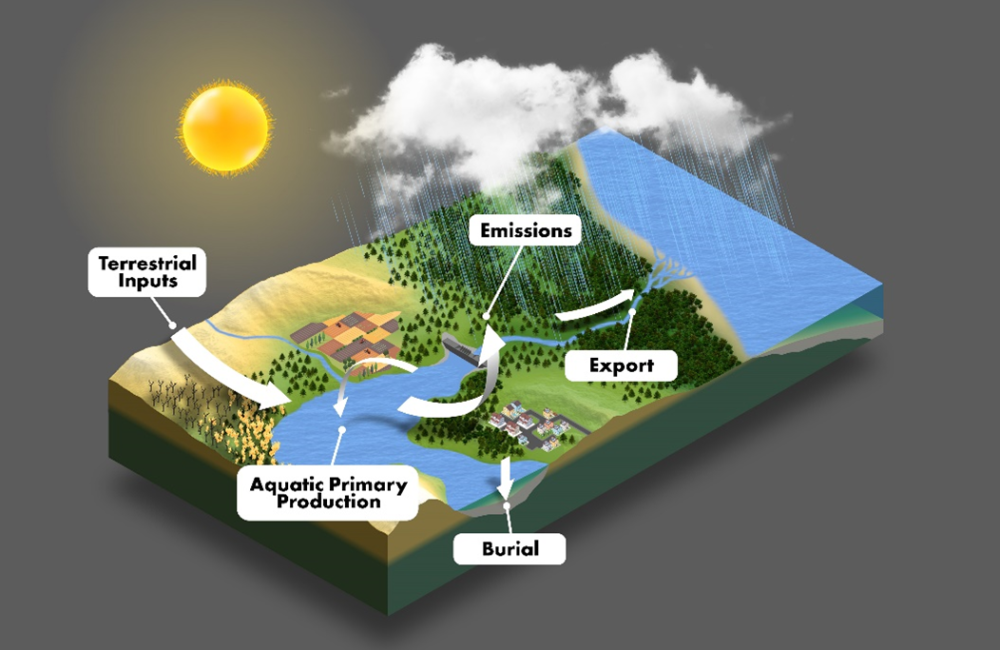2022-09-06 オークリッジ国立研究所(ORNL)

ORNL scientists synthesizing research on the complex biogeochemical processes at play in inland waters found that carbon emissions are about 13% higher than previously estimated. Credit: Adam Malin/ORNL, U.S. Dept. of Energy
研究者らは、これまでの推定値を新たにモデル化し、乾燥したり縮小したりしている水域を含む、より多くの種類の水域からのサンプリングやデータを改善した上で、内陸水域は年間44億トンの炭素を大気中に送り出していると推定している。この炭素の約73%は、二酸化炭素またはメタンとして排出される。
<関連情報>
- https://www.ornl.gov/news/inland-water-carbon-emissions-rise
- https://onlinelibrary.wiley.com/doi/10.1111/gcb.16324
人為的な気候・景観の変化が内陸水域の炭素動態に及ぼす影響。我々は何を学び、どこに向かっているのか? Anthropogenically driven climate and landscape change effects on inland water carbon dynamics: What have we learned and where are we going?
Rachel M. Pilla,Natalie A. Griffiths,Lianhong Gu,Shih-Chieh Kao,Ryan McManamay,Daniel M. Ricciuto,Xiaoying Shi
Global Change Biology Published: 20 July 2022
DOI:https://doi.org/10.1111/gcb.16324
Notice: This manuscript has been authored by UT-Battelle, LLC, under contract DE-AC05-00OR22725 with the US Department of Energy (DOE). The US government retains and the publisher, by accepting the article for publication, acknowledges that the US government retains a nonexclusive, paid-up, irrevocable, worldwide license to publish or reproduce the published form of this manuscript, or allow others to do so, for US government purposes. DOE will provide public access to these results of federally sponsored research in accordance with the DOE Public Access Plan (http://energy.gov/downloads/doe-public-access-plan).
Abstract
Inland waters serve as important hydrological connections between the terrestrial landscape and oceans but are often overlooked in global carbon (C) budgets and Earth System Models. Terrestrially derived C entering inland waters from the watershed can be transported to oceans but over 83% is either buried in sediments or emitted to the atmosphere before reaching oceans. Anthropogenic pressures such as climate and landscape changes are altering the magnitude of these C fluxes in inland waters. Here, we synthesize the most recent estimates of C fluxes and the differential contributions across inland waterbody types (rivers, streams, lakes, reservoirs, and ponds), including recent measurements that incorporate improved sampling methods, small waterbodies, and dried areas. Across all inland waters, we report a global C emission estimate of 4.40 Pg C/year (95% confidence interval: 3.95–4.85 Pg C/year), representing a 13% increase from the most recent estimate. We also review the mechanisms by which the most globally widespread anthropogenically driven climate and landscape changes influence inland water C fluxes. The majority of these drivers are expected to influence terrestrial C inputs to inland waters due to alterations in terrestrial C quality and quantity, hydrological pathways, and biogeochemical processing. We recommend four research priorities for the future study of anthropogenic alterations to inland water C fluxes: (1) before-and-after measurements of C fluxes associated with climate change events and landscape changes, (2) better quantification of C input from land, (3) improved assessment of spatial coverage and contributions of small inland waterbodies to C fluxes, and (4) integration of dried and drawdown areas to global C flux estimates. Improved measurements of inland water C fluxes and quantification of uncertainty in these estimates will be vital to understanding both terrestrial C losses and the “moving target” of inland water C emissions in response to rapid and complex anthropogenic pressures.



